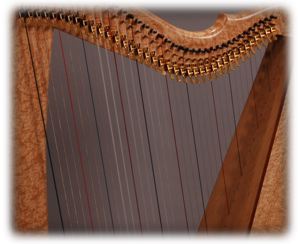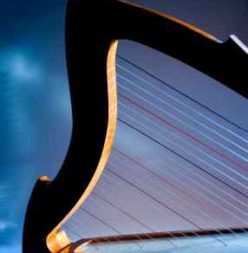Techniques that Add Sparkle to Your Playing
 There are many special “harp effects”: techniques for creating sounds on the harp beyond the “ordinary” realm of the plucked string. Every harp method includes the introduction of the most common effects on harp, such as the harmonic, playing pres de la table (pdlt), or close to the soundboard, and the glissando. I’ll start with some variations of these techniques that add even more sound possibilities to your tool kit.
There are many special “harp effects”: techniques for creating sounds on the harp beyond the “ordinary” realm of the plucked string. Every harp method includes the introduction of the most common effects on harp, such as the harmonic, playing pres de la table (pdlt), or close to the soundboard, and the glissando. I’ll start with some variations of these techniques that add even more sound possibilities to your tool kit.
Glissando Variations
Instead of playing a standard, one-finger glissando, try the “bunny ears” glissando that Kim Robertson teaches. Using fingers two and three of the right hand, upside-down–in other words, with your wrist rotated forward so that finger two is lower than finger three–place your fingers on two strings a third apart (such as C and E). Now drag your fingers upwards, letting both strike the strings in succession.
Try a triad gliss: Like the bunny ears, with fingers 4, 3, and 2 on a triad (eg. C E G), with finger 4 leading.
Another variation is the South American muffled or damped glissando, where the third finger muffles each string the second just played.
Then there’s the octave glissando with fingers 4 and 2; keep finger 3 tucked out of the way and lead with 4.
Variations on Harmonics
You can create harmonics by “cutting” the string not only at the midpoint, but higher on the string, where the pitch that sounds will be not one octave higher but an octave plus a fifth. There are further harmonics, but they get progressively harder to play. Of course, you can also experiment with double and even triple harmonics. Playing two harmonics with one hand requires squeezing the strings slightly together as you pull your fingers closed. Try it!
Variations on Playing pdlt
Playing pdlt, or right down at the soundboard, creates a guitar-like sound. You can experiment with playing “low in the strings” (bas dans les cordes, or bdlc) for a sound that’s in between. Playing high in the strings creates another interesting variation in sound.
Different Kinds of Pluck
Xylo Technique: Place your fingers of your left hand against a few strings, right where they come from the soundboard. Use your right hand to play the same strings, creating a popping, xylophone sound.
Pincé Technique: Place thumb and index finger on the same string. As you pluck with your thumb and finger 2 together, you “pinch” the string, creating a percussive sound.
Nails Technique: Use your fingernails to strike the single notes of a melody.
Strange & Intriguing Sounds
Lever Slide: Pluck the string, and flip the lever while it’s vibrating. This sound is wonderful for endings in jazzy pieces.
Another variation is to bend the note by pressing on the string between the bridge pin and the tuning pin, if there is enough space of your harp to do so. (Left hand presses string while right hand plays).
Tuning Key Slide: Use the metal end of your tuning key. (If yours has a plastic sleeve, simply remove it). Pluck the string with finger two of your left hand, and use your right hand to run the tuning key down the vibrating string.
Getting Slap Happy
Muffling Techniques: Playing thumbs-up (etouffée) on single notes or octaves with the left hand to create a jazzy, slap-bass sound, or immediately replacing the notes just played for a crisp sound.
Percussive Techniques: Knocking on the soundboard, slapping the soundboard, knocking or slapping the back of the harp. In the lower strings, you can slap a whole section for a gong-like sound.
Paper weaving: This one is really different. You weave strips of paper into the strings, close to the soundboard, and then play. Experiment with the interesting sounds you can create!
Check out the books (and/or videos and classes) of Kim Robertson, Alfredo Rolando Ortiz, and Bernard Andrès for these harp effects and other techniques and pieces that use them.
Have some favorite harp effects that I’ve forgotten? Let me know.

